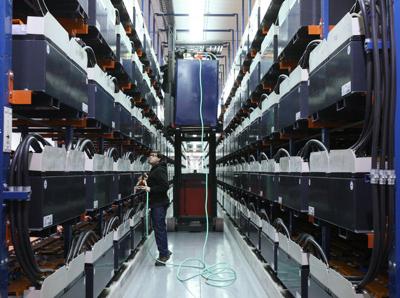Golden Valley Electric Association (GVEA) plans to revise the scope of two major federal grant programs following guidance from the U.S. Department of Agriculture.
GVEA was approved for the two programs through the USDA’s Rural Utility Service, which combine forgivable low-interest loans and grant funding.
The $206 million New ERA package was originally intended to fund a new battery energy storage system, critical substation upgrades west of Fairbanks, and help secure a power-purchase agreement for major wind energy projects. It also included refinancing for GVEA’s Healy Power Plant Unit No. 2 (Healy 2), a coal-fired plant, with plans to eventually retire the facility.
The $100 million Powering Affordable Clean Energy (PACE) allocation would support a second battery storage facility, transmission and substation upgrades in Nenana, and a power-purchase agreement for a future solar farm.
Both packages were frozen under President Donald Trump’s Jan. 20 executive order, which initiated a 90-day review of all Biden-era programs. Trump has long criticized former President Joe Biden’s clean energy efforts funded by the Inflation Reduction Act and the Bipartisan Infrastructure Law.
During a Tuesday meeting, GVEA Environmental Officer Namoi Morton-Knight told the utility’s board of directors that GVEA was invited to revise the scope of both projects.
“We are working to figure out how to move these programs forward within the constraints of the original publication and guidelines, and meeting the updated executive orders,” Knight said. “This is to keep the conversation with RUS going.”
She noted that federal funding had already been committed because GVEA was far along in the program process. GVEA is also the only utility in the nation to receive both PACE and New ERA funding.
GVEA will remove the solar farm from its PACE project scope, largely because its developer, Renewable IPP, placed all projects on hold. Renewable IPP’s main investor pulled out in February after its federal funding sources were frozen.
Knight said GVEA will still include battery storage and transmission/substation upgrades in the revised PACE application.
“The project will really be focused on the battery component,” Knight said.
GVEA will also remove the Healy 2 retirement component from its New ERA application but will retain plans for transmission upgrades, battery storage, and wind energy power-purchase agreements.
“With all the uncertainty over Southcentral Alaska utilities’ natural gas supply, we didn’t feel it was prudent to commit to a specific retirement date for Healy 2,” Knight said. “The retirement of Healy 2 depended on the economic replacement of baseload power.”
In 2022, GVEA’s board approved a strategic generation plan to close the problematic Healy 2 plant by the end of 2024, replacing it with a mix of purchased power from Southcentral utilities, wind power, and battery storage. However, a looming natural gas shortage in Cook Inlet removed the Southcentral power option from consideration, leading GVEA to continue operating Healy 2.
Despite the funding uncertainties, GVEA has continued system studies for two wind projects: the Alaska Renewables-led Shovel Creek project and the Ameresco project in Delta Junction. Knight said the projects align with the state’s interest in a renewable portfolio standard, goals to reduce carbon emissions, and the Railbelt utilities’ efforts to conserve natural gas.
An in-depth analysis showed that GVEA must first upgrade its transmission lines and build new battery storage facilities before integrating significant renewable energy sources. Without those upgrades, additional power generation could damage GVEA’s infrastructure. The studies will also evaluate whether the projects offer long-term economic benefits to GVEA’s members.
At Tuesday’s meeting, some GVEA members expressed disappointment about the removal of the Healy 2 retirement plan and frustration with the perceived slow progress on wind energy.
Member Richard Thielmann encouraged the board to pursue multiple power-purchase agreements instead of a piecemeal approach. GVEA is currently focused on the Shovel Creek project due to its advanced technical data and turbine specifications.
“Throw spaghetti on the wall and see what sticks,” Thielmann said. “It’s no risk to you. The IPPs (independent power producers) have to do all the paperwork, take all the risks, and cough up the money to guarantee how much electricity they’re going to sell to you.”
Eleanor Gagnon said she plans to move back to the Lower 48, in part due to poor air quality worsening her asthma.
“You guys are making decisions that will affect future generations,” she said, citing the state’s cultural and recreational activities like fishing and outdoor traditions. Gagnon urged the board to reject the proposed changes.
“We deserve to breathe clean air … a lot of us feel how we breathe clean air is affected by how we generate power,” Gagnon said.
At the meeting’s close, board president Tom DeLong clarified that the application revisions are just the beginning of an ongoing conversation with the USDA.
Editorial note: This story has been corrected to reflect who provided the update on GVEA's federal funding applications. Environmental Officer Naomi Morton-Knight provided the report.

